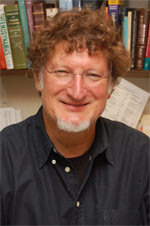Ben-Amotz Research featured in Nature
2012-12-06

Professor Physical Chemistry
Water transforms into a previously unknown structure in between a liquid and a vapor when in contact with alcohol molecules containing long oily chains, according to Purdue University researchers. However, around short oily chains water is more icelike.
Water plays a huge role in biological processes, from protein folding to membrane formation, and it could be that this transformation is useful in a way not yet understood, said Dor Ben-Amotz, the professor of chemistry who led the research.
Ben-Amotz's research team found that as they examined alcohols with increasingly long carbon chains, the transformation occurred at lower and lower temperatures.
When in contact with a chain seven carbon atoms long, the water molecules became much looser and more vaporlike at a temperature of 140 degrees Fahrenheit, which is about halfway between the melting and boiling points.
"For oils with chains longer than four carbons, or about one nanometer in length, we saw the water transform into a completely new structure as the temperature rose," Ben-Amotz said. "If the trend we saw holds true, then this transformation could be happening at body temperature around important physiological molecules like proteins and phospholipids."
Water responds very sensitively in its structure to small changes, he said.
"Water's versatility is what makes it so special," he said. "For instance, the surfaces of proteins have both oily and charged regions; and water changes itself to accommodate these very different components and everything in between. We are learning more about exactly how it does this."
The researchers found that water molecules interacting with the oil always formed a more ordered, icelike structure at lower temperatures, while the bulk of the water remained liquid. This ice-like structure would melt away as the temperatures increased and in longer molecules a new structure would appear, he said.
A paper detailing the National Science Foundation-funded work is published in the current issue of Nature and is also highlighted in a news and views article in the same issue. In addition to Ben-Amotz, co-authors include Purdue graduate student Joel Davis and postdoctoral fellows Kamil Gierszal and Ping Wang.
The team's observations add to a more than 70-year debate over the interaction of oil and water, with some studies suggesting that water forms little icebergs around the oil molecules, while others point to a more disordered, vaporlike water structure.
Article link:
Related links:
Source:
Purdue University News Service